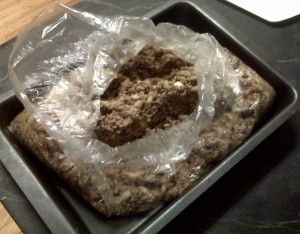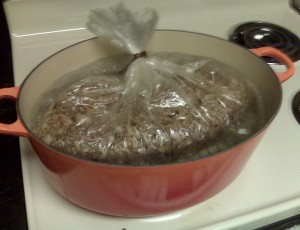Ok, it’s been 2.5 hours. I don’t know if it’s ready, but I sure am! So I popped it out of the water, opened up the bag, held my breath in anticipation, and …  …so much for “loaf-like.” It’s late, so I’m going to pop it in the fridge overnight and see if it, um, congeals by the morning. And if it doesn’t, I’m just mash it together with my little hands and plunk it down on the frying pan. D’ya know why? Because it’s Delicious. I couldn’t stop eating it. My worst fear was that it would taste like meatloaf. It definitely does not. It’s got fascinating flavors. The onion flavor permeates the whole thing. The ginger and ground coriander works well with the poultry. I think it’s yummy. We’ll see if I still think that in the light of day.
…so much for “loaf-like.” It’s late, so I’m going to pop it in the fridge overnight and see if it, um, congeals by the morning. And if it doesn’t, I’m just mash it together with my little hands and plunk it down on the frying pan. D’ya know why? Because it’s Delicious. I couldn’t stop eating it. My worst fear was that it would taste like meatloaf. It definitely does not. It’s got fascinating flavors. The onion flavor permeates the whole thing. The ginger and ground coriander works well with the poultry. I think it’s yummy. We’ll see if I still think that in the light of day.
Category Archives: Uncategorized
3 Hours?
I’m not exactly sure how long to boil this. One recipe says 1.5 hours. Most others say to boil for 3 hours. Really? What exactly is happening that needs 3 hours? I think I might test it at 2.5 hours.
1.5 Hours Later
It’s definitely expanding. It’s also coming together nicely. Becoming more loaf-like.

1.5 Hours Down, One To Go
It’s Finally Time!
Time to Cook!
Time to Mix!
The recipe I’m adapting calls for 1 cup of lamb/mutton liver, 1 cup of lamb/mutton hearts, and 1 pound of ground lamb (in place of the tongue or whatever the traditional bits were). I had been planning to use 1 cup of hearts and 1 cup of gizzard. Then I was planning to use all of the ground turkey neck plus enough plain old ground turkey (1% fat, of course!) to make 1 pound. I found that I had a whole lot of gizzard and heart, though. And after tasting those cooked, I’m pretty confident that the haggis won’t go wrong if I use more of those than planned. Plus, I’m a little concerned about the lower fat content. Will it hold together properly if I use 99% lean turkey? I have no idea! It’s all a gigantic experiment, so … let’s experiment! Here’s what ended up in my bowl. You’ll have to forgive my measurements. 1 coarsely chopped vidalia onion (about 2 1/4 cups) 1/2 pound minced, cooked turkey necks 1 c. plus 1/4 pound minced, cooked chicken hearts 1 c. plus 1/4 pound minced, cooked turkey gizzards
Time to add spices! The thing that I love about this mixture is that all of the meat is cooked, so it’s easy to keep tasting it to see if the spices are working. I ended up with: 1 1/2 tsp salt 3 1/2 tsp ground black pepper 1 1/2 tsp nutmeg 1 tsp ginger 1 tsp coriander 1/2 tsp cayenne Yum. Then add the oats, which add a really nice crunchiness at this stage.
But it’s a pretty dry mix. The recipes I’ve read all say that it’s supposed to sort of stick together. So I add: 3 Tbsp lemon juice 1/4 c. canola oil And I run out of canola oil. Great job of checking for ingredients ahead of time. So I add 1/2 c. of olive oil. I think that may not be the best substitution, but I WANT MY HAGGIS!!! And I can’t add butter. That would just defeat the whole purpose of this experiment. But boy, I bet it would be tasty. Hm. It still doesn’t seem quite moist enough. But I don’t want to add more fat… In goes 1/3 c. of the reserved cooking liquid from the hearts/necks/gizzards! Now it’s nice and moist. Maybe… too moist. Damn. 1/4 c. of currants and, voila!
Can I cook it yet? Can I Can I Can I????
The Inaugural Use of the Meat Mincer
The gizzards were a little bit hard to grind because it was hard to feed them through the mincer properly. But they came out looking much like hash, which was the goal.
Ground gizzard looks much less, um, weird than plain old cooked gizzard, so Official Tester and I were finally brave enough to try it. It tastes just like turkey, but a bit stronger. Official Tester (OT) thought there was a strange aftertaste. I didn’t notice it. The good news is that I didn’t overcook them, as far as I can tell. The hearts fed through the grinder much more easily. I could have just chopped them, but then what’s the point of having a meat mincer? In future, I might consider chopping them because the noise of the hearts being fed through the mincer was a bit off-putting. (I could describe it more vividly, but choose to leave it to your imagination.) The hearts came out of the mincer much differently than the gizzards did. The hearts came out in more of a stream, spaghetti-like.
After prying the meat off of the neck bones and trying to separate out the gristle or whatever that weird sheathing material was, I minced that, too. Oddly, the meat was much more tender and moist from the neck bones that were in the freezer from our last roast turkey. The neck bones that I bought yesterday were very, very difficult to work with. Many thanks to OT for the mincer. What a great Christmas gift!
Meats Done!
Toasted Scottish Oats
Step 1
Boil the meats (except the ground turkey) for about an hour. You may be surprised to learn that I can’t find anything telling me how long I need to boil chicken hearts before they’re done. But if turkey gizzards take an hour or less (and have some fascinating uses), chicken hearts can’t take anywhere near that long.

Interesting Bits on Boil
The Ingredients
Traditional haggis, as I mentioned, includes the parts of a sheep that you may not want to eat by themselves. Like ingredients in sausage products, these are ingredients that Americans tend not to like to think about. Out of sight, out of mind. But in this age of additives, and having just read David Kessler’s book The End of Overeating, I’m actually a bit more at peace with these kinds of ingredients than with, say, the ingredients in McDonald’s Chicken McNuggets. I also like the idea of putting all of the parts of the animal to good use. (Hopefully my haggis turns out to be a “good use!”) To avoid the cholesterol and fat problems presented by lamb/mutton or beef, I considered using lower-fat meats like venison or goat. Venison is available at our local butcher. Goat is available at our local international supermarket. But I challenge you to find nutrition information on venison & goat heart and liver. Plus, as it turns out, I would have to special-order the offal, and I wanted to start my project this weekend! As luck turns out, though, our local international supermarket stocks terrific poultry ingredients. I think that these should be lower in fat and cholesterol than the mutton/beef equivalents. I realize that the flavor will be affected significantly, but I hope that these will give it the rich flavor that prevents haggis from being just another meatloaf. To substitute for mutton hearts, I’m using chicken hearts. (The heart is a muscle, not an organ, so it seemed important to stick with hearts.)
To substitute for mutton liver, I’m using turkey gizzard. (I couldn’t find other poultry organ meats.)
To substitute for mutton tongue, I’m using turkey necks. (Again, it’s a muscle.) And some ground turkey.
The Great 2009 Healthy Haggis Challenge
I’ve been meaning to make haggis for some time. I know what you’re thinking: why? Several reasons, really. I had a little haggis in Stirling, Scotland when I was there in 2002, and it was really quite tasty. I like a challenge, and I’ve been trying to break out of my food safe-zone. And I got a sausage grinder for Christmas last year and need to try it out. Probably most importantly, I’m part Scot, so once I’ve decided on something, there’s really no changing my mind. And if it’s terrible, what have I really lost? So I started scouting haggis recipes, and here’s what I learned: Traditional haggis is pretty bad for you. The traditional ingredients (sheep heart & sheep liver) are really, really high in cholesterol. The “substitute” ingredients (beef heart & beef liver) are not much of an improvement. Even a Scottish government report in 2006 said that haggis should only be eaten once a week. So my quest is not just to make haggis, but to make a tasty <strong>and</strong> relatively healthier haggis. This is the story of my quest.













